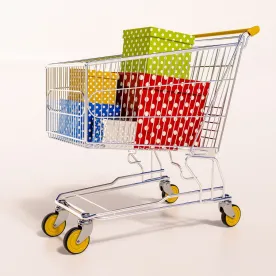You’ve seen it on the evening news, read it on the net, and for those of you who still read newspapers, you’ve seen it there as well. The global supply chain for all kinds of goods has been bottle-necked now for months. Think it will get better by the Christmas holidays? Don’t count on it.
The “global supply chain bottleneck in all ports in the U.S. is going to get worse before it gets better, especially with Black Friday and the holiday shopping season approaching. Now, this logistics backup is because of the COVID-related factory shutdowns in Asia, coupled with lots of consumer spending here at home,” said Alisa Chang, National Public Radio, October 26, 2021.
The Bottleneck in the Supply Chain
“When everybody was staying home, and they were getting stimulus checks, they started buying. Since they weren’t going on vacation and going to restaurants and buying services, they started buying furniture and bicycles and home improvement goods,” said Roger Guenther, Executive Director of the Port of Houston.
There’s been a lot of online and media chatter that the bottleneck in the supply chain is due to the tension between U.S. and China. But as Susan Golicic, Director of the Supply Chain Management Forum at Colorado State University, said in an email, “these ships are allowed to enter the ports to be loaded and unloaded.”
In reality, “the cargo backlogs are mostly due to shortages in shipping capacities. There are not enough dock workers and equipment handling containers at ports, and not enough truck drivers picking up the containers unloaded from the container ships,” said Tao Lu, Associate Professor of Operations and Information Management, University of Connecticut, adding “The primary reasons for the supply chain problems are rising consumer demand, increased shipping costs, production constraints and labor shortages around the world.”
COVID and the Global Supply Chain
U.S. consumer spending increased 0.80% in August amid a surge in COVID-19 cases, even as soaring demand and backed-up supply chains kept inflation high. It seems that consumers were still spending their stimulus check on durable goods and restaurants, reported Christopher Rugaber, Fortune, and the AP (10-01-2021).
So, what’s causing all this back-up? Basically, it’s on both ends of the global supply chain. With the Delta variant surging in different parts of the globe at different times, its impact has affected manufacturers, transportation, and logistics. Earlier in the year, factories were shut down in various parts of the Pacific Rim due to the Delta variant. For example, there were lockdowns in Vietnam where orders for Nike footwear were delayed months at the footwear factories.
In the U.S., many container ships are anchored off the coast of Los Angeles, the Port of Houston, and elsewhere due to the shortage of labor to off-load the ships, the shortage of trailers and trucks for the containers, and a material shortage of drivers to get those containers to their end destination. As John Burnett said in his piece on National Public Radio on October 26, “[L]et’s review. The overseas factory has to produce. The container ship has to transport. The port has to receive. That truck has to deliver. The warehouse has to store. And the retailer has to get to the consumer.” If any part of that supply chain fails or is delayed, the back-up is exacerbated and your Halloween scarecrow sits on a ship, and your video game lives in a container…somewhere.




 />i
/>i

